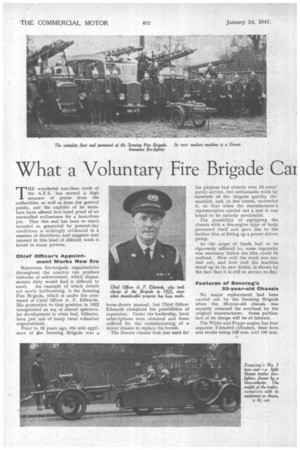What a Voluntary Fire Brigade C perform by Enthusiasm
Page 24

Page 25

If you've noticed an error in this article please click here to report it so we can fix it.
IrrHE wonderful war-time work of the A.F.S. has earned a high measure of praise from the authorities, as well as from the general public, and the exploits of its members have offered first-hand proof of an unexcelled enthusiasm for a hazardous job. That this zeal has been as much revealed as generated by present-day conditions is strikingly evidenced in a number of directions, and suggests that interest in this kind of difficult work is latent in many persons.
Chief Officer's Appointment Marks New Era
Numerous fire-brigade organizations throughout the country can produce histories of achievement, which dispassionate duty would find it difficult to excel. An example of which details are newly forthcoming, is the Sunning Fire Brigade, which is under the command of Chief Officer A. F. Edwards. His promotion to that position in 1922 inaugurated an era of almost spectacular development in what had, hitherto, been just one of many rural volunteer organizations.
Prior to 18 years ago, the sole appliance of he Sunning Brigade was a
horse-drawn manual, but Chief Officer Edwards visualized the possibilities of expansion. Under hisleadership, local subscriptions were obtained and these sufficed for the commissioning, of a motor chassis to replace the horses.
The Dennis chassis that was used for the purpose had already seen 15. years' public service, but enthusiastic work by members of the brigade quickly dismantled, and, in due course, re-erected it, so that when the manufacturer's representative carried out a test it was found to be entirely serviceable.
The possibility of equipping the chassis with a fire-engine type of body presented itself and gave rise to the further idea of fitting up a power-driven pump.
As the scope of funds had to be rigorously adhered to, some ingenuity was necessary before the idea could be realized. How well the work was carried out, and how well the machine stood up to its new duties, is shown by the fact that it is still in service to-day,
Features of Sonning's 33-year-old Chassis
No major replacement had been carried out by the Sunning Brigade when the 33-year-old chassis was recently returned for overhaul by the original manufacturer. Some particulars of its design will be of interest.
The White and Poppe engine has four separate T-headed cylinders, their bore and stroke being 120 mm. and 130 mm.
respectively, The caps over the inlet valves were designed for two sparking plugs, but now ignition is by magneto only, to a single set of plugs. Lubrication is on. the dry-sump principle, with a double oil pump for scavenging and for feed.
Originally, the water-circulating pump was incorporated in the front end of the crankcase, where it was driven from the exhaust camshaft, but leakage from the, gland into the sump was experienced, and, consequently, the pump was lifted to a higher position, the spaces between the teeth of the driving pinion being filled , up with white metal and the fiat-belt drive to the fan triangulated.
The original water-circulation system is maintained, and in this the coolant passes from the base of the radiator through the pump and then through each of the cylinder heads in turn before returning to the header tank.
The gearbox is, as might be expected, constructed as a separate unit from the 'clutch and engine. . Immediately for-, ward of it a sprocket was fitted giving a vertical chain drive to a .second sprocket which could be dog-clutched to the pump driving shaft, on which it normally ran freely. This form of conversion was introduced for this• special job,iand has become widely known since as the " Sonning Drive."
At the rear of the machine is a Dennis turbine-type pump rated at 250 g.p.m.
"Contributions from Insurance Companies" • The services of this machine greatly strengthened the finance of the brigade, with acceptable contributions from insurance companies, so that in 1929 the position warranted the acquisition of another appliance. In the light of its experience up to that time, it is not surprising that the brigade turned to the Dennis range for its new machine, and selected the 250-gallon model, powered by a four-cylindered 85 nun., by 120 mm, engine.
In due course a Dennis single-cylindered trailer pump was acquired, this having an output of 80-110 g.p.m. and, being an extremely valuable machine for use in rural areas, where the only supply of water is frequently from wells inaccessible to self-propelled pumps. This trailer is light enough to be drawn to the scene of action by a three
wheeler as is indicated an accompanying illustration.
Then followed the fourth appliance, which comprises a Dennis tender which had already seen service with the Birmingham Brigade,
In 1938 the Sonning authorities commissioned a further Dennis fire-engine chassis and pump, upon which was con
structed a body designed by themselves and incorporating ideas of the chief officer.
A streamlined limousine, it provides complete weather protection, which has proved of immeasurable value to members of the brigade when called upon— as they have been—to attend fires as far afield as Birmingham, London, Southampton and Bristol.
The Possessions of the • Voluntary Brigade It is noteworthy that not only are all five machines the sole property of this energetic, efficient and entirely voluntary brigade, but it also owns its main station at Sonning and a substation at Mortimer, together with bell circuits and an electric siren for summoning the members to duty.
Whilst great credit attaches to the officers and personnel of the Sonning Brigade, it would not be fair to overlook the contribution made to their undoubted success by the veteran Dennis and its, younger fire-fighting assistants.




















































